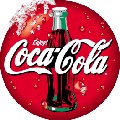The History of Coca-Cola
Coca-Cola (also known as Coke) is a popular carbonated soft drink sold in stores, restaurants and vending machines in over two hundred countries. It is one of the world's most recognizable and widely sold commercial brands. Coke's major rival is Pepsi. The wave shape (known as the "dynamic ribbon device") present on all Coca-Cola cans throughout the world derives from the contour of the original Coca-Cola bottles. Coca-Cola was invented by John S. Pemberton in 1886 in Columbus, Georgia, originally as a cocawine called Pemberton's French Wine Coca. It was initially sold as a patent medicine for five cents a glass at soda fountains, which were popular in America at the time thanks to a belief that carbonated water was good for the health.
It was relaunched as a soft drink to counter Prohibition. The first sales were made at Jacob's Pharmacy in Atlanta, Georgia on May 8, 1886, and for the first eight months only thirteen drinks were sold each day. Pemberton then ran the first advertisement for the beverage on May 29 of the same year in the Atlanta Journal.
Asa Griggs Candler bought out Pemberton and his partners in 1887 and began aggressively marketing the product. The efficacy of this concerted advertising campaign would not be realized until much later. By the time of its 50th anniversary, the drink had reached the status of a national symbol.
Coca-Cola was sold in bottles for the first time on March 12, 1894 and cans of Coke first appeared in 1955.
Asa Candler was tentative about bottling the drink, but the two entrepreneurs who proposed the idea were so persuasive that Candler signed a contract giving them control of the procedure. However, the loosely-termed contract proved to be problematic for the company for decades to come. Legal matters were not helped by the decision of the bottlers to subcontract to other companies, in effect, becoming parent bottlers.
When the United States entered World War II, Coke was provided free to American soldiers, as a patriotic drink. The popularity of the drink exploded in the wake of World War II as American soldiers returned home, more grateful than ever to partake of a beverage that had become synonymous with the American way of life.

